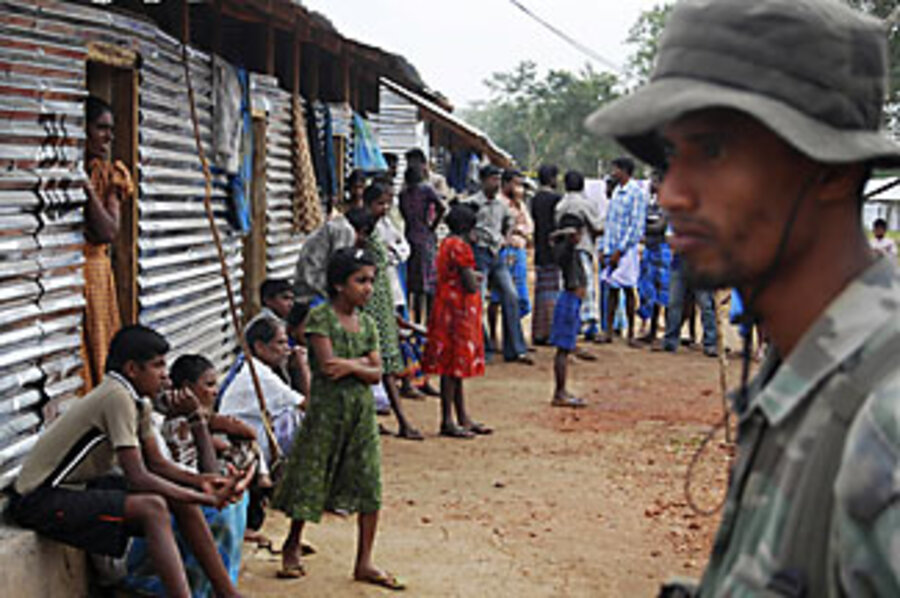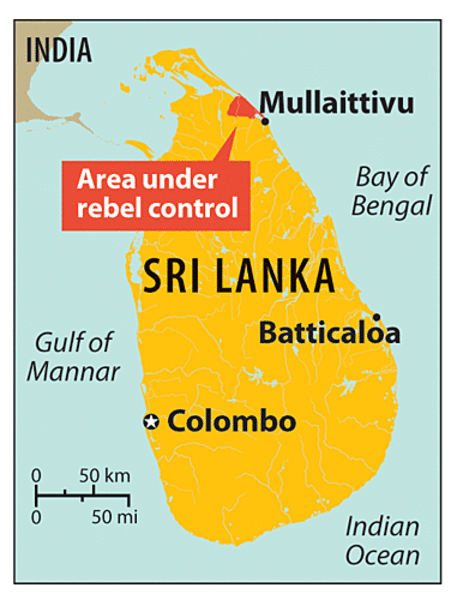Fighting threatens Sri Lankan civilians
Loading...
| Bangkok, Thailand
Government forces in Sri Lanka say they are closing in on the last redoubt of the Tamil Tigers, which appear on the verge of defeat after 26 years of war. In recent weeks, troops have captured towns and strategic roads in the disputed north and blockaded sea lanes, boxing the insurgents into a shrinking area.
But as the military advances rapidly, human rights groups and humanitarian agencies have raised the alarm over the fate of some 230,000 civilians trapped by ground fighting and aerial attacks. Many have been forced to flee by the retreating Liberation Tigers of Tamil Eelam, making it hard to deliver aid and evacuate the injured.
In an echo of the Gaza conflict, the government has blocked access for almost all news media and relief agencies. It has also withheld casualty figures, while President Mahinda Rajapaksa has rallied public support behind an all-out push to defeat the rebels.
Since September, the International Committee of the Red Cross has been the only relief organization allowed into the Vanni region where the fighting is under way. Last week, the ICRC expressed "serious concerns" over the "physical safety and living conditions" of displaced civilians.
The last relief convoy on Jan. 16 was able to deliver food and evacuate some patients in four ambulances. But others are still stranded and require urgent treatment, says ICRC spokeswoman Sarasi Wijeratne. Increasing numbers of displaced civilians are fleeing the fighting, she says by e-mail.
Rights groups say the LTTE and government troops are to blame for the escalating humanitarian crisis. By preventing civilians from fleeing, the rebels are using them as human shields.
The LTTE is accused of recruiting child soldiers and crushing dissent in its territory. It seeks a separate state for minority Tamils in the north and east of the country. It alleges mistreatment at the hands of ethnic Sinhalese, who make up 75 percent of a population of 20 million.
In recent weeks, as more LTTE towns have fallen, several hundred civilians have escaped to government-held areas, where they are confined to Army-run camps. The government says it needs to screen them for rebels. But as Sri Lanka braces for a larger exodus from the Vanni, international donors should press for external monitoring of camp conditions, says Yolanda Foster, a researcher for Amnesty International.
Many of those on the run have been repeatedly forced to move and have exhausted their savings. "People are on the move because they are so desperate and fearful of attack," she says.
A presidential adviser said Sunday that government agencies were preparing space for up to 30,000 displaced people at three camps. Military officials have warned that the Tigers could try to infiltrate ethnic Tamil populations and launch surprise attacks. The US categorizes the LTTE, known for bold attacks on political opponents, as a terrorist group. In 1991, it sent a female suicide bomber to assassinate Indian Prime Minister Rajiv Gandhi, who had sent peacekeepers to Sri Lanka.
On Wednesday, a suspected LTTE bomb planted outside a police station in eastern Sri Lanka killed a police officer and a civilian. Government forces recaptured the ethnically mixed east in 2007, but it remains largely under tight military control, despite promises to lift emergency restrictions, say rights groups and political analysts.
This bodes poorly for postwar planning in the north, says Paikiasothy Saravanamuttu, executive director of the Center for Policy Alternatives in Colombo. The emphasis on defeating the enemy has obscured serious thinking on how to bind a distrustful minority into a fractured country. "If you don't have a political solution and a way to resolve the [political] conflict, you may have three to four years of relative peace and then the whole thing starts off again," he says.
The election of Mr. Rajapaksa in 2005 and the subsequent collapse of a 2002 Norwegian-brokered cease-fire have put Sri Lanka on a war footing. His government has said that a defeat of the LTTE, which it believes is imminent, would be followed by a political settlement. But some government lawmakers have equated devolution – explored in 2002 – as a sellout to the enemy.
The military suggested Sunday that LTTE leader Vellupillai Prabhakaran may have escaped.
The Navy said Tuesday it had sunk four LTTE vessels off the northeast coast. The boats are part of a once substantial war machine, including light aircraft.
The government's hawkish approach to the conflict has correlated with a spike in attacks on critical voices within the Sinhalese community. Earlier this month, a prominent newspaper editor, Lasantha Wickrematunge, was shot dead on the street. He had angered the government by alleging graft in military procurement and criticizing the erosion of civil liberties.
In an editorial prepared beforehand and posthumously published, Mr. Wickrematunge accused the administration of Rajapaksa – whom he knew personally – of seeking his death.
"Murder has become the primary tool whereby the state seeks to control the organs of liberty. Today it is the journalists, tomorrow it will be the judges," he wrote.






